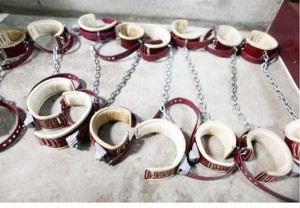WASHINGTON, (Reuters) – The Guantanamo military prison guards call it a “cocktail,” the mix of faeces, urine and spit that inmates hurl at them and that dramatizes the soldiers’ view that they are serving on a battlefield.

The inmates talk of their years behind steel doors, many held without charges, and denounce their American jailers as “attackers of Muslims … with blood on your hands.”
The day-to-day tensions between inmates — some of whom charge torture — and the troops who guard them are vividly depicted from both perspectives in a new National Geographic documentary, “Explorer: Inside Guantanamo.”
“This is still an integral part of the war on terror,” Guantanamo’s “warden,” Col. Bruce Vargo said in the movie. A former inmate agrees, calling Guantanamo a physical and psychological “war zone.”
The documentary is the first in-depth look at the detention center for terrorism suspects that has become a worldwide symbol of U.S. abuses in fighting terrorism after the Sept. 11 attacks. National Geographic Channel will broadcast it tomorrow evening in the United States and other countries.
It may also be the last such look — President Barack Obama in January ordered the facility at the U.S. naval base on Guantanamo Bay, Cuba, closed within a year. His administration is studying what to do with about 240 detainees who remain.
“Guantanamo Bay was the legal equivalent of outer space — a place with no law,” former Navy defense lawyer Charles Swift says in the movie.
Swift’s client, Salim Ahmed Hamdan, won major Supreme Court rulings giving Guantanamo prisoners rights in U.S. courts.
The 1-1/2 hour film was shot last August, at a time that the Bush administration was insisting it was impossible to close Guantanamo despite worldwide condemnation.
Crews also visited Afghanistan and England to interview released inmates, and spoke with U.S. policy makers, intelligence officials and lawyers on both sides of the issue.
The movie depicts the daily routine in a cellblock of Guantanamo’s concrete-and-steel maximum-security facility. Guards make suicide checks every three minutes; inmates banter or taunt; a Muslim librarian hands out books, or soldiers rush with face shields and rubber gloves to quell a disturbance.
TIGHT SHACKLES,
WINDOWLESS ROOMS
It shows the vine-covered ruins of Camp X-Ray — the open cages where inmates in orange jump suits were first held in 2002 and led tightly shackled to nearby wooden shacks for interrogations in tight, windowless rooms.
The film also traces post-Sept. 11 U.S. policy toward terrorism suspects, from vilification, to the harsh interrogations and the military leaders who fought them, to Supreme Court rulings and to what the military now casts as respectful, humane treatment.
Along the way, former President George Bush denounces militants as “nothing but a bunch of cold-blood killers, and that’s the way we’re going to treat ‘em.”
A Bush lawyer runs down a list of difficult options: “Once you capture those people you can’t release them,” former White House associate counsel Bradford Berenson said. “You can’t kill them — that would be a violation of international law.”
A Guantanamo guard orients new guards last year: “You can be fair, firm and impartial, without being a dickhead … people know,” he said.
But in the prison, an inmate shouts from his cell: “Never, never, I am here for seven years, I never get my rights.”
Another says the guards are putting on a show for the camera crew, which is barred from interviewing him. “It’s pretty good service now,” the inmate says, laughing. “One hour ago, you bad guys don’t care about anything.”
“If you believe this propaganda, I am Santa,” he says.
Across the Atlantic, released inmate Moazzam Begg, a British citizen held from 2002-2004, says he nearly went insane during solitary confinement on suspicions he was financing terrorism, and wished a storm would sweep him away.
“Everything that I was had ended. Being a father had ended. Being a brother, a husband, a son,” Begg said.
Key figures involved in the film say it fairly depicted the prison and debate.
“It gives a 360-degree view and people can make up their own mind,” said Charles Stimson, a former Pentagon chief for detainee affairs, who helped get Geographic into Guantanamo.
He told a panel discussion after an advance screening this week that he had hoped the effort would help narrow a “chasm” in reality between Guantanamo now and the years it gained notoriety.
Defense attorney Sarah Havens cautioned that closing Guantanamo would not cleanse a questionable U.S. human rights record, as long as Obama’s administration continues to assert it can hold some prisoners without trial.
“If they pick up these detainees and move them to the United States and detain them indefinitely, Guantanamo still exists as a concept,” she said.




